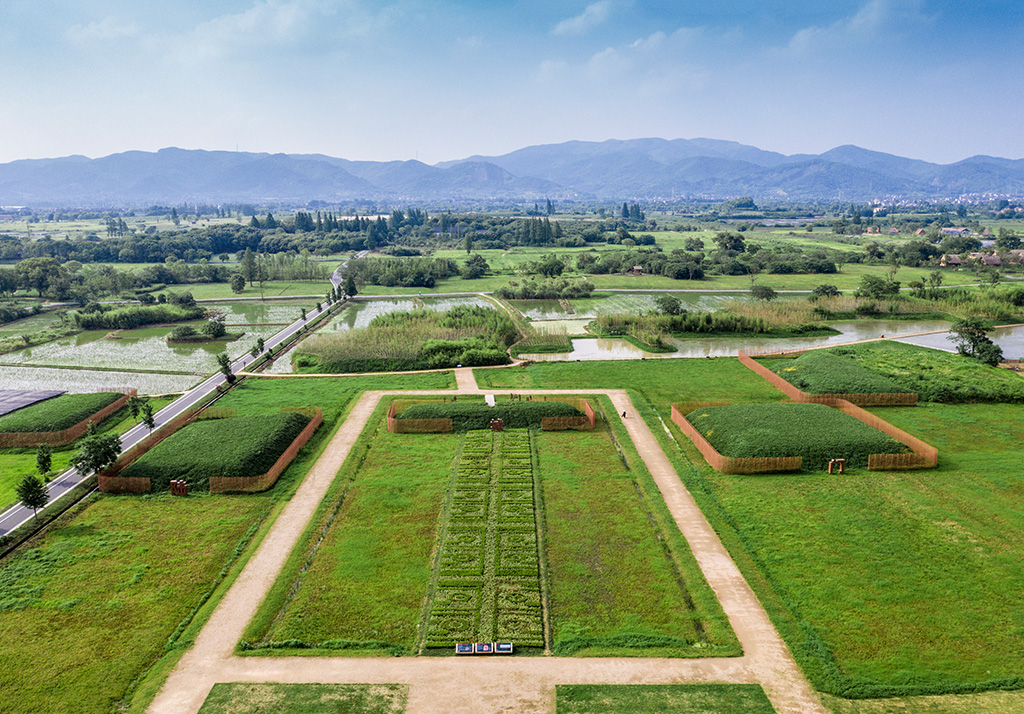Of Liangzhu City Park
Liangzhu is a sacred place to showcase the 5,000-year-old Chinese civilization, and the Archaeological Ruins of Liangzhu City Park is an important place to experience and comprehend it. The Archaeological Ruins of Liangzhu City Park covers an area of 3.66 km2 with the 3-km2 inner city as its core. There are 10 sites in the park for visitors, include City Gates & Walls, Archaeological Experience Area, Site of River Courses and Workshops, Zhishan Viewing Platform, Mojiaoshan Palace, Fanshan Cemetery, Ruins of the West City Wall, Fengshan Research and Study Base, Daguanshan Recreation Area, and the Deer Garden. Visiting all of them takes about 3 hours.
The Archaeological Ruins of Liangzhu City Park is a park for the presentation of archaeological ruins. It is quite different from normal city parks or theme parks. To protect the ruins is our unchangeable priority. Other functions such as presentation, education, research, tourism, leisure and so on must serve the purpose for the effective protection of the physical fabric of the property and its environment, and will be realized on the basis that authenticity and integrity of the property are protected. Therefore, the construction of the park strictly follows the rules of “protection first, minimum intervention, and genuinely reversible”. Through means of greenery signs, simulated reconstruction, sculptured scenario, digital demonstration, exhibition hall and so on, we try to restore the ancient landforms in the Liangzhu Period, reveal the heritage value of Liangzhu Ancient City, and highlight the importance of this sacred place representing China’s 5,000-year civilization. It aims to help visitors to gain a deep understanding of the features and value of the civilization embodied by the Archaeological Ruins of Liangzhu City.


Reconstruction of City Wall

South Wall Exhibition Area

Land Gate

Water Gate
Liangzhugang River has been silently flowing for 5,000 years, which runs in the west-east direction and connects between the inside and the outside of the East City Wall. The technique using rows of timber piles on both sides of the river to protect the banks had already been adopted by the ancestors in the Liangzhu Period. Zhongjiagang is the exhibition area of Residences and Workshops.
We use metal grid figures to simulate the scene of handicraft production in the Liangzhu Period, which vividly demonstrates the specialized process of handicraft production at that time. Interactive experience projects for the making of jades, lacquerware and tops can help visitors feel the handicraft production techniques of the Liangzhu ancestors.

Reconstructed Workshop Area of Zhongjiagang

Zhongjiagang’s Ancient River Courses

Mojiaoshan Palance

Aerial View of Mojiaoshan Palace

Model of Mojiaoshan Palace
According to archaeological excavations, there had been moats both inside and outside the ancient city walls, which was very different from the layout of many cities in ancient China. The total length of moats outside the city walls was 3,000 meters and they connected with bigger waters farther outside. The inner moats were 6,500 meters long in total and apart from that, over 50 ancient river courses were also found inside the city. At the north, east, and south side of Mojiaoshan Palace Area each was a main river course, together presenting an I-shaped layout. Many channels connected between the inner moats and the main river courses, thus forming a crisscrossing network of rivers.
These rivers and the inner and outer moats were mostly artificial and the total length of them was over 30 km. The connection of rivers and moats inside and outside the city forged a convenient traffic network for the Ancient City, making it worthy of the title as a Water City. 5,000 years has passed, but visitors can still picture in their mind how rice had been planted far away from the city, how stones had been collected and big trees felled from nearby hills and then transported into the city through the river courses.
Visitors can also imagine how the jades, lacquerware and other high-end handicraft products were distributed to every corner of the Kingdom of Liangzhu through bigger waters connected with these river courses. The busy scenes of boats and rafts coming and going may give visitors an idea of the position of Liangzhu Ancient City 5,000 years ago as the economic, political and belief center for the distribution area of Liangzhu Culture and the core of the Kingdom of Liangzhu.
Mojiaoshan is the center of Liangzhu Ancient City and the most important site for visitors to the park. It will take around 1 hour to visit the whole area. Visitors can go to Mojiaoshan Palace Area, Sand and Soil Ground, or Mojiaoshan Eastern Slope Exhibition Area, learn about planning and site selection of the Ancient City, layout of the palace, and construction techniques of the artificial terraces and the Sand and Soil Ground, and imagine the grand scene of Liangzhu Ancient City 5,000 years ago.

The Bamboo Path in Zhishan

Zhishan in Summer

Aerial View of Zhishan

Fanshan Royal Cemetery Reconstructed Exhibition
In 1986, archaeologists from the Zhejiang Provincial Institute of Cultural Relics and Archaeology discovered the royal cemetery in the period of Liangzhu Culture not far from the west side of Mojiaoshan. It is the highest grade cemetery found in the Liangzhu Culture area so far, known as “Fanshan Cemetery”. Archaeologists have cleared 11 well-arranged large tombs of Liangzhu Culture in an area of more than 600m2. Except for two tombs damaged due to external forces, the other nine tombs are well preserved. The archaeological findings in the Fanshan Cemetery are quite shocking. The burial objects include more than 1,200 pieces (sets) of precious cultural relics such as jade, stone, ivory and jade inlaid lacquer articles. Among them, jade articles account for more than 90%. Such a large number of high-standard and exquisitely made jade articles were not seen in other sites of Liangzhu Culture at that time, and are almost incomparable today.

Fanshan Royal Cemetery Reconstructed Exhibition Site

Model of Mojiaoshan Palace

West City Wall

Deer Park at Daguanshan